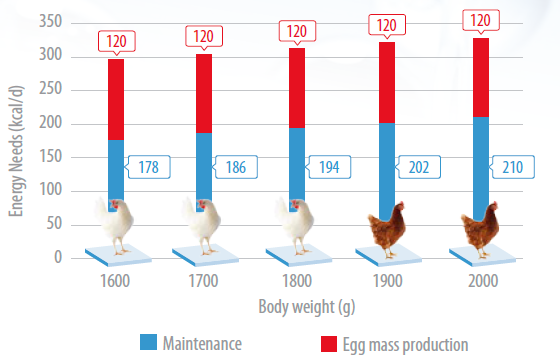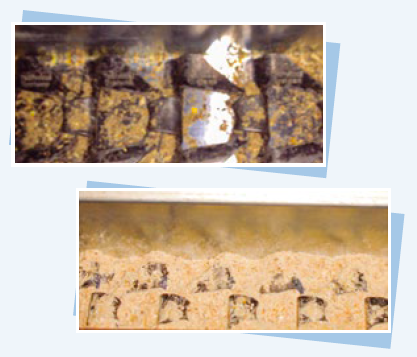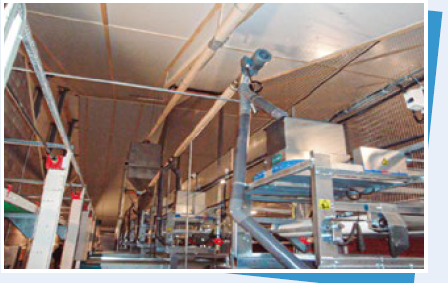
Animal Nutrition
Feeding Management In Layers
To read more content about AviNews March 2024
Animal Nutrition
To read more content about AviNews March 2024
Content available at:
Indonesia (Indonesian) Melayu (Malay) ไทย (Thai) Tiếng Việt (Vietnamese) Philipino
The genetic potential of the H&N layers is remarkable, and thanks to constant investments in our breeding program, will keep on improving.
To make the most of this genetic potential, we need to ensure that all factors related to management, feed, the environment, and overall health status is always operating at the optimum level.
1.It is well known that feed plays a major role in achieving this goal, while also having a great impact on the production cost.
2.We must also remember that the layer hens have a selective feed intake, meaning she will only eat all the nutrients of the feed if the structure is attractive.
3.The feed mill receives raw materials all with a different size and density so they need to be well processed, mixed, and combined in a homogeneous structure so that layer hens will eat the full nutrient package and cannot selectively eat.
The layer hens have a selective feed intake, meaning she will only eat all the nutrients of the feed if the structure is attractive.
Selective feed intake is an innate behaviour, so to help us overcome these challenges, we would like to highlight some
of the farm management techniques that can be applied for achieving the optimum feed intake with the correct nutrient profile that the layer hen needs for a performance according to its genetic potential.
In this article the different aspects related to feed management during production will be covered.
It is assumed that a good rearing has been done and the flock has a good uniformity and a good body weight development. Furthermore, it is taken for granted that an adequate feed intake training has been applied, especially from week 10-11 onwards, that guarantees a good development of the bird’s digestive tract.
Eating behavior
The main driver of feed intake in layer hens is to supply and match their energy needs.
The energy needs are determined by the hen’s requirements for maintenance, growth, and egg mass production.
The main driver for the daily energy need is the body weight, therefore it is important to permanently know the average body weight and uniformity of each flock and understand how it impacts the behavior of the birds within the flock.
Daily energy needs
As the bird grows, the daily energy needs will increase (see Graphic 1). This will impact the feed intake of each bird.
Feed formulation is normally calculated for an average bird, but those above average will be the ones struggling to get what they need.
The larger birds, normally with a higher hierarchy within the flock, will have the opportunity of selecting and eating what they want (mainly big particles high in energy), and the less dominant hens generally get what is left (small particles high in amino acids and vitamins).
Consequently, if the feed structure is not homogeneous, both groups will then get an unbalanced intake of nutrients.
To minimize this problem maintaining a good flock uniformity combined with adequate feeding space per bird is essential. (This will be discussed later in further detail).
Another factor that can impact feed intake behaviour is the temperature of the barn. The layer hen’s energy intake increases as the temperature drops and reduces as the temperature increases.
At temperatures below 20º C feed intake will increase and there will be a higher requirement to utilise energy to maintain body temperature. While this will affect feed efficiency, performance is often not affected.
To avoid the challenge caused by temperatures out of the layer comfort zone, it is recommended to invest in a good ventilation/ heating system and ensure the building has efficient insulation.
Looking further into selective feed intake, research shows that the limiting factor for the selection of what they eat is the particle size and not one specific nutrient.
Hens will naturally select the larger particles over the smaller nutrients you generally find at the bottom of the feeders. If we don’t control this behavior, then the average geometric mean of the feed will be reduced. (Graphic 2, Adapted from Herrera et al., 2018).

Graphic 2. Evolution of the geometric mean of the feed with time (Adapted from Herrera et al., 2018).
Furthermore, we need to consider that the feed intake will increase based on the needs of the layer hen during the day.
In production, the layer hen will increase the feed intake in the afternoon as the requirements for egg production increase.
Generally, 60-70% of the daily feed intake is taken in the afternoon (Graphic 3).
Feed deliveries should be adjusted to meet this demand.
Pay especial attention to free range production since the birds might stay outside for long periods of time.
They should get a full meal before they go to the range.
Overcoming feeding challenges
In the next bullet points, we would like to provide some practical recommendations that can help to achieve the balance between feed and nutrient intake on the farm.
1.CORRECT FEED DELIVERY
From the age of 5 weeks onwards it is advised to train the animals to empty the feeders once a day (Picture 1).

Picture 1. An example of an empty feeder chain (first picture) taken in an area of high activity and an example of a low level of feed (second picture) in a normal area. This low feed level should be achieved once a day.
By doing this, the birds are encouraged to eat the finer particles of the feed. During this training period, it is IMPORTANT to have somebody present to monitor the behaviour of the animals, especially in cagefree systems to ensure the feed is not restricted and undue stress is placed on the flock.
This should be done by block feeding.
Block feeding is simply running two feeds in quick succession. The aim is to offer all birds a complete feed with a balanced nutrient content.
The empty trough will have made the birds hungry; the dominant birds will be the first ones to the feeders where they will eat and become satiated. When the second feed runs the less dominant birds will find it easier to access the feeders and allow them to get a complete feed and not the leftovers of the dominant birds.
It is highly advisable to continue this practice of feeding to an empty trough in the production house after transfer. To prevent any impact on egg production cycles it is advisable to implement the empty trough method around noon.
Furthermore, at this time the farm staff will be working around and can react in case of unexpected events. Also bear in mind that 40% of the feed will be consumed in the morning and 60% in the afternoon. So, plan your feeding program accordingly.
Make sure that there is always feed available at the latter part of the day. This is to ensure there is enough feed available during egg production in the afternoon period. The last feed should be run around two hours before lights out.
2.TRAINING FEED INTAKE CAPACITY DURING WEEK 10 TO 17
During this period, we need to promote a good feed intake to aid the development of the digestive organs as well as to promote feed intake capacity prior to the beginning of the production cycle.
The limiting factor for feed intake is the gut size, stimulating, and therefore increasing the size of the crop, proventriculum, gizzard and intestine during this period will allow the bird to have a larger feed storage capacity. This is essential to allow the hens to ingest and digest a complete balanced feed.
A mature hen eats 100-120 grams depending on several factors such as breed, feed nutrient density and production environment.
A hen that has been trained in rear for a larger intake capacity will not only transition easier into the production cycle but will also be in a better position to adapt to the challenges in the egg production phase.
Block feeding is simply running two feeds in quick succession. The aim is to offer all birds a complete feed with a balanced nutrient content after managing the feeding times for the birds empty the feeders.
3.UNIFORMITY OF THE FLOCK
Good uniformity within the flock will reduce the competition among the layer hens.
This will allow all the birds the opportunity to eat a fully balanced meal therefore improving the nutrient balance within the flock.
Furthermore, the actual requirements of the individual hens within the flock will be more closely aligned to the calculated average flock nutrient needs.
A mature hen eats 100-120 grams depending on several factors such as breed, feed nutrient density and production environment.
4.EQUAL DELIVERY OF THE FEED
This has a direct impact on the uniformity of the flock.
Feeder space: In cage production, this is a limiting factor for achieving good flock uniformity in both rearing and production. It will also limit dramatically the growth of the pullets (see Table 1).
5.FAST DELIVERY OF THE FEED
This is an important factor especially for cage free production. In this kind of production system, birds are free to choose where and often what to eat.
It is key to deliver the feed as fast as possible so that the feeders along the barn are quickly filled and the birds don’t have the option of selection during the feed delivery.
In practice this is not so easy to achieve, and it can often be seen how a group of birds are congregated at the beginning of the feeders trying to select the big particles while at the end of the feeding line there is only fine particles available for the hens in this area (see Picture 2), this problem is exacerbated when the feed delivery system runs slowly.

Picture 2. Example of feed collected at the beginning (left) and at the end (right) of the feeding line.
It is key to deliver the feed as fast as possible so that the feeders along the barn are quickly filled and the birds don’t have the option of selection during the feed delivery.
Before building a barn especially in alternative systems it is important to pay special attention to the feeding system:

Picture 3. Example of a good dimensioned feed delivery.
6. MONITOR WATER CONSUMPTION
Clean water of good quality and adequate temperature must always be available. Birds must have access to a sufficient number of evenly distributed drinkers. Extra attention is necessary in hot climates.
The water system must be checked and cleaned regularly to ensure functionality.
Water consumption must be closely monitored as birds that are not drinking appropriately will often have a lower feed intake which can impact on body development and production.
The water system must be checked and cleaned regularly to ensure functionality.
Present and future challenges
Currently, beak treatment is still allowed in many countries, however some north European countries have already banned this practice while others have chosen not to implement it themselves.
IN SUMMARY